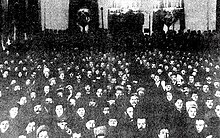
Back Tut-Rusia Kongreso de Sovetoj Esperanto Congreso Panruso de los Sóviets Spanish کنگره کشوری شوراها Persian Yleisvenäläinen neuvostokongressi Finnish Congreso dos Soviets de Todas As Rusias Galician Kongres Soviet Seluruh Rusia ID Congresso panrusso dei Soviet Italian 全ロシア・ソビエト会議 Japanese სრულიად რუსეთის საბჭოების ყრილობა Georgian Congresso dos Sovietes de Toda a Rússia Portuguese
All-Russian Congress of Soviets Всероссийский Съезд Советов | |
|---|---|
 | |
| Type | |
| Type | |
| History | |
| Established | 1917 |
| Disbanded | 1937 |
| Preceded by | |
| Succeeded by | Supreme Soviet of Russia |
| Elections | |
| Indirect election | |
| Meeting place | |
 | |
| Second All-Russian Congress of Soviets (November 7–9) in Petrograd, Smolny The Congress had no permanent location. | |
The All-Russian Congress of Soviets evolved from 1917 to become the supreme governing body of the Russian Soviet Federative Socialist Republic from 1918 until 1936, effectively. The 1918 Constitution of the Russian SFSR mandated that Congress shall convene at least twice a year, with the duties of defining (and amending) the principles of the Soviet Constitution and ratifying peace treaties.[1][2] The October Revolution ousted the provisional government of 1917, making the Congress of Soviets the sole, and supreme governing body. This Congress was not the same as the Congress of Soviets of the Soviet Union which governed the whole Soviet Union after its creation in 1922.
For the earlier portion of its life, the Congress was a democratic body. Over Russia there were hundreds of soviets, democratic local governing bodies in which the surrounding population could participate. The soviets elected the delegates to the Congress, and then in turn the Congress held the national authority, making the highest decisions. There were several political parties represented in the various sessions of the Congress, each of which fought for increasing their own influence in the soviets. However, as the Russian Civil War progressed, the soviets' authority was progressively reduced,[clarification needed] with the rise of Stalinism effectively cementing this situation[3] and decisively turning the Congress into a rubber stamp. The Congress was formed of representatives of city councils (1 delegate per 25,000 voters) and the congresses of the provincial (oblast) and autonomous republican councils (1 deputy for every 125,000 inhabitants).
The exclusive jurisdiction of the Congress consisted of the election of the All-Russian Central Executive Committee, adoption of the Constitution of the Russian SFSR and amendments to it, approval of amendments proposed by the Central Executive Committee, and approval of the autonomous republics' constitutions. On the other issues, the Congress and the Central Executive Committee had the same authority. The Congress ceased to exist at the end of the constitutional reform of 1936–1937, when first on the union and then at the republican levels indirect election to Soviets were replaced by direct elections at all levels with the Supreme Soviet as the highest legislative body.
- ^ Constitution (Fundamental Law) of the RSFSR
- ^ Jerry F. Hough, Merle Fainsod, How the Soviet Union is Governed, US: Harvard College, 1979, reprint, p. 50-51 61–63, 67–68, 73, 81–84.
- ^ Models of Democracy, David Held, p. 225. "Stalinism destroyed the possibility of a radical workers' democracy, installed briefly in the Soviet Union in October 1917 under Lenin's leadership"